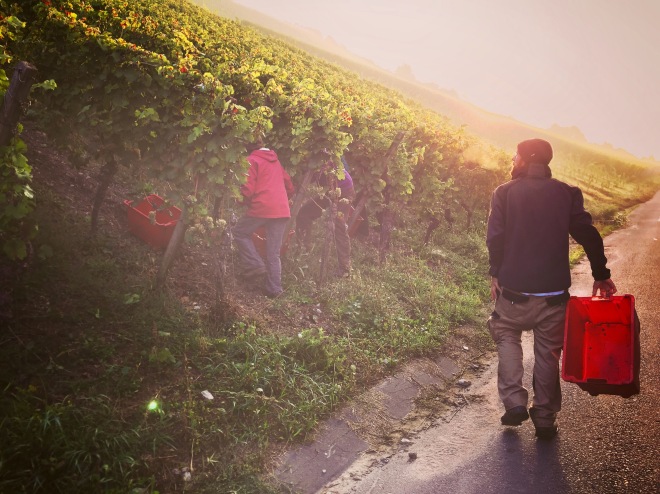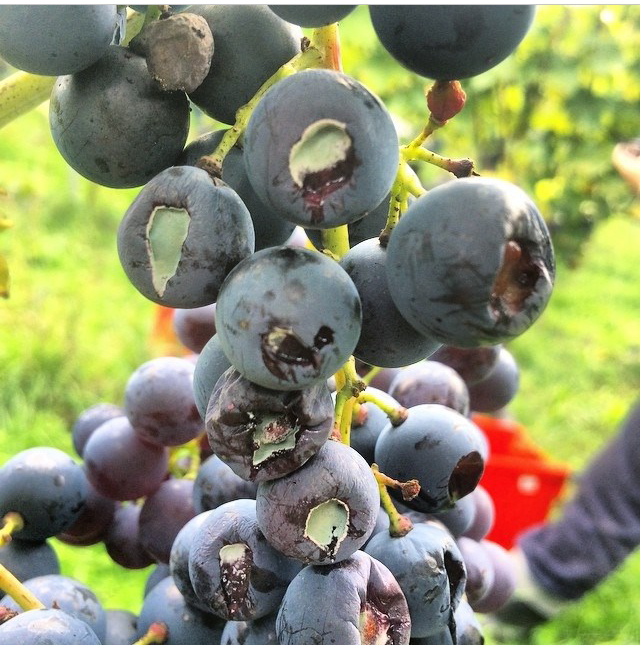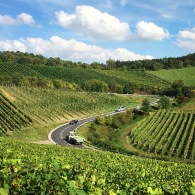
September 4th, 2017 marked the earliest start to harvest that winemaker Ludwig Knoll, in Germany’s Franken region, had ever seen. With about 38 hectares (94 acres) of vines, 90% of which are hand-harvested, it took nearly seven full weeks to complete. In 2018, they started a whopping two weeks earlier – in the middle of August! Did somebody say “climate change”?
So what does a winemaker need to consider when it comes time for the big crush? How do they know when to start? Do they simply begin with the vineyard farthest from home and work their way back? That might make sense logistically, but is there more to it than that? After-all, the entire years efforts have led up to this crucial time of year, so how does it all go down and what’s the big stress about anyway? How hard can it be?

When I worked my first harvest I was pretty shocked to learn how much goes into the picking process, but maybe you won’t be. Maybe you are already a savvy wine-o and have worked a few harvests yourself! Either way, I’m going to explain, from my experience, how the whole process is broken down.
Let’s start with the basics.

Above the equator harvest generally occurs between August and November. Below the equator, between February and April.
A winemaker wants to wait for each different grape varietal to reach it’s optimal ripeness for the style of wine they intend to make using that fruit. Deciding exactly when that time has arrived is probably the single most important decision in the whole winemaking process. Every varietal ripens at a certain pace, for example: Cabernet Sauvignon will need longer than early ripening varieties like Tempranillo or Chardonnay.

Weather plays a huge role in the decision of when to harvest what, which means that staying informed about drastic changes is absolutely essential. For example: Let’s say you take a walk through your best Riesling site to sample the fruit and decide that it could benefit from another 5 days on the vine. But then you check the weather forecast and see that a heavy rainstorm is on the way… Is it worth it to leave your best grapes hanging when you know that the rain will likely dilute and bloat them – maybe even causing some to burst?
If I were that winemaker I’d get out there and pick that fruit at the latest possible moment before the rain starts, and in the meantime I would also prioritise my other top sites before the lower qualities.

Of course, rain isn’t the only threatening factor. There’s also humidity, heat, cold, hail and sometimes even frost to keep in mind. Excessive heat during harvest will result in overripe fruit with too much sugar and not enough remaining acidity. Since sugar converts to alcohol during fermentation that can leave you with a boozy, unbalanced, one-dimensional wine. Excessive cold on the other hand can result in overly acidic wines with strong green vegetal notes. Hail, perhaps the most obvious of examples, breaks the berries open on impact and damages the leaf canopy. Without enough leaves the bunches are exposed to potentially damaging sun exposure which can burn the berries. With too few leaves a vine will also struggle to photosynthesise and nourish itself. The punctured berries will leak their sweet juice attracting unwanted attention from bees, wasps and other animals, and unless they dry quickly enough, will begin to rot.

So, how do you know when the grapes have reached their ‘optimal ripeness’?
A grape’s ripeness can be determined in a number of ways. Tasting is of course always the first step, but even the color of the seeds and stems tells us a great deal with the change from green to brown indicating that the grapes are physiologically ripe. For more accuracy the juice is measured with a refractometer to reveal its sweetness (Brix or Oechsle), titration tests are carried out to asses acidity, and so on and so forth.

As I mentioned before, the level of ripeness a winemaker aims to achieve depends on the style of wine they want to produce. For a sparkling wine it is best to harvest early – before the fruit reaches its physiological ripeness – when the grapes still have a high amount of acidity. For a sweet wine like ice wine you need very concentrated fruit with a lot of sugar and that comes from leaving the grapes to hang longer than all the rest. Ice wine grapes are left on the vine until temperatures drop down low enough for the berries to freeze. The required temperature is around -8°C (17.6°F), but -10°C is safer since the berries will warm up a little during transport. They are then pressed so that the sugary juice is separated from the frozen water remaining in the berry. The tiny amount of concentrated grape must remaining is then made into precious ice wine.


How a winemaker chooses to harvest the fruit is another big topic. Grapes can be collected mechanically or by hand. I personally believe that hand-harvesting is the best option, but not all winemakers have the luxury of (or interest in) working that way. Often times there aren’t enough seasonal workers available for picking, and maintaining a team large enough to get you through the weeks of harvest all year round just isn’t feasible.
Another factor is time pressure. The larger wineries with hundreds of hectares of vines are more likely to rely on mechanical harvesting because it is more efficient. A harvesting machine can run 24 hours a day – yes, even at night – and brings in a much larger amount than a single worker can in the same amount of time. It is more cost-effective to use a machine and it also eliminates the de-stemming process that would otherwise require a separate machine before the grapes reach the press.

A machine harvester works by straddling a row of vines and using rubber sticks, it hits the stocks from both sides. The berries, shaken from their stems, fall onto a conveyor belt that transports them into a large holding bin in the machine. Easy enough, right?!
So what are the disadvantages?
The machines are not able to determine quality. They cannot tell if the fruit is unripe, rotten, disease infected, or if it is even fruit at all and not a small birds nest or anything else that could be hidden beneath the foliage. It’s up to the vineyard manager to check the vineyard first and decide if it is suitable for machine-use. Sometimes he or she will even decide to have a team of workers come through and do a pre-selection by hand before the machine is brought in – but using people and the machine is not cheap.

On top of the quality control issues the machines cannot operate on steep slopes; they can damage vines causing them to age pre-maturely; the skins of the grapes are often perforated during the shake-down process which leads to oxidation, maceration and color bleeding; and finally, there is the contamination issue that exists when diseased berries, like those infected by powdery mildew for example (a fungal disease which can alter the chemical composition of a wine, create unfavourable aromas, increase phenolics and bitterness, etc.), are mixed in with the good fruit.


Harvesting by hand is tedious work, but if you have a well-trained and motivated team the benefits are clear and the results are incredible.
Typically a single worker carries a box and bucket with them in order to sort the different qualities. For example: Botrytis is a beneficial kind of fungus that affects wine grapes and is often referred to as ‘noble rot’. It occurs in moist conditions and can be used to make fine, concentrated sweet wines. Often times harvest workers will use the bigger box to collect the healthy ripe grapes and the smaller bucket to collect the botrytized grapes. At the bottom or end of each row the containers are all emptied into larger sorted boxes that are then picked up by a tractor, loaded onto a truck and transported to the winery.

Not all grapes in one site will ripen at the same time, even if they are the same varietal. That means that it is often necessary to work through a single vineyard 3 or 4 times at different stages during harvest in order to take the best quality available every one of those times and leave the less ripe hanging until the next sweep, or the next one after that. Once this year, on the last day of harvest, we actually worked on 6 small sites sweeping each one twice (on top of the 4 sweeps we’d made in the previous weeks) We worked on all 6 sites once in the morning and once right before sunset. The idea was that the very best grapes got that one last full day in the sun – even if it only meant a difference of 1,5 or 2 hours for some of the grapes and a half day of extra work for 30 people. That’s what I call dedication!

I’m a huge believer that quality wine comes from quality in the vineyard and minimal intervention in the cellar, so you have to be willing to work for that top condition outside. Plus, it doesn’t hurt that your ass will also be in top condition after walking up and down the steep slopes for 10 hours a day, 6 days a week for 7 weeks!
Great ass & great wine. Those are two pretty convincing reasons to harvest by hand if you ask me. I guess I’ll just leave it at that 😉 .
#nuffsaid

Thanks for reading and don’t forget to follow my daily wine adventures on Instagram!

















I’m more of a Franconian beer man but their wine is very underrated and when I drink wine in Germany, it’s mostly from Franconia.
LikeLiked by 1 person